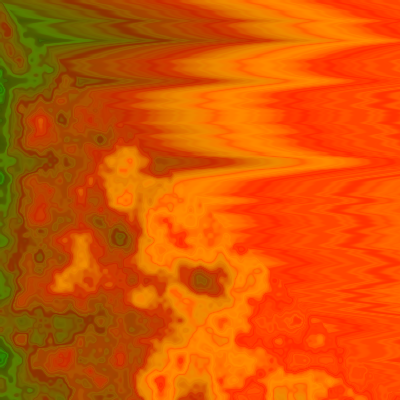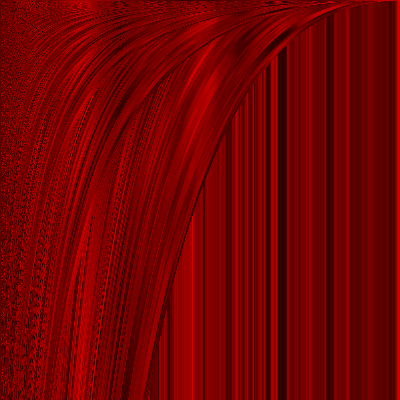Much like transpiling register machines, now we have a chance to transpile stack machines. Unfortunately, it doesn’t actually speed up the code nearly so much (the stack is just not as effective of a memory structure in this case), but it’s still an interesting bit of code.
In this case, we turn something like this:
invsub
polT
writeG
id
neg
zero?
sin
invsub
ZERO
inv
Into this:
function(X, Y) {
this.x = X;
this.y = Y;
this.stack = [];
this.r = undefined;
this.g = undefined;
this.b = undefined;
this.stack.push(X);
this.stack.push(Y);
var arg0 = 0;
var arg1 = 0;
var arg2 = 0;
var result = 0;
// invsub
arg0 = this.stack.pop() || 0;
result = 1 - arg0;
result = result % 1.0;
this.stack.push(result);
// polT
arg0 = this.stack.pop() || 0;
arg1 = this.stack.pop() || 0;
result = Math.atan2(arg0, arg1);
result = result % 1.0;
this.stack.push(result);
// writeG
arg0 = this.stack.pop() || 0;
this.g = arg0;
// id
arg0 = this.stack.pop() || 0;
result = arg0;
result = result % 1.0;
this.stack.push(result);
// neg
arg0 = this.stack.pop() || 0;
result = -arg0;
result = result % 1.0;
this.stack.push(result);
// zero?
arg0 = this.stack.pop() || 0;
arg1 = this.stack.pop() || 0;
arg2 = this.stack.pop() || 0;
result = arg0 === 0 ? arg1 : arg2;
result = result % 1.0;
this.stack.push(result);
// sin
arg0 = this.stack.pop() || 0;
result = Math.sin(arg0);
result = result % 1.0;
this.stack.push(result);
// invsub
arg0 = this.stack.pop() || 0;
result = 1 - arg0;
result = result % 1.0;
this.stack.push(result);
// ZERO
result = 0;
result = result % 1.0;
this.stack.push(result);
// inv
arg0 = this.stack.pop() || 0;
result = 1 / arg0;
result = result % 1.0;
this.stack.push(result);
return [
this.r === undefined ? this.stack.pop() || 0 : this.r,
this.g === undefined ? this.stack.pop() || 0 : this.g,
this.b === undefined ? this.stack.pop() || 0 : this.b,
];
}
The code is not actually that much different for transpiling:
transpile() {
let patterns = [
/^\((.*?)\) => (.*?)$/,
/^function\((.*?)\) ({.*?})$/,
]
let code = [
`
this.run = function(X, Y) {
this.x = X;
this.y = Y;
this.stack = [];
this.r = undefined;
this.g = undefined;
this.b = undefined;
this.stack.push(X);
this.stack.push(Y);
`];
// Find the maximum arity of any function
var maxLength = 0;
for (var command of this.program) {
maxLength = Math.max(maxLength, command.function.length);
}
for (var i = 0; i < maxLength; i++) {
code.push(` var arg${i} = 0;`)
}
code.push(` var result = 0;`)
code.push('');
for (command of this.program) {
let f = command.function.toString();
for (var pattern of patterns) {
// Match each kind of function
let parts = f.match(pattern);
if (parts) {
code.push(` // ${command.name}`);
// Pop the number of parameters we need
for (var i = 0; i < command.function.length; i++) {
code.push(` arg${i} = this.stack.pop() || 0;`)
}
// Add the code
var line = ` result = ${parts[2]};`;
var noResult = false;
if (parts[2].includes('{')) {
if (parts[2].includes('return')) {
line = parts[2].replace('return', 'result = ');
} else {
line = parts[2];
noResult = true;
}
line = ' ' + line.replace(/^{|}$/g, '').trim();
}
if (parts[1]) {
parts[1].split(',').map((el, i) => {
line = line.replaceAll(
new RegExp("\\b" + el.trim() + "\\b", "g"),
`arg${i}`
);
});
}
code.push(line);
if (!noResult) {
if (params.modeCall === "clamp") {
code.push(` result = result < 0 ? 0.0 : (result > 1 : 1.0);`);
} else if (params.modeCall == "wrap") {
code.push(` result = result % 1.0;`);
}
code.push(` this.stack.push(result);`);
}
code.push('');
}
}
}
code.push(`
return [
this.r === undefined ? this.stack.pop() || 0 : this.r,
this.g === undefined ? this.stack.pop() || 0 : this.g,
this.b === undefined ? this.stack.pop() || 0 : this.b,
];
`);
code.push('}');
code = code.join('\n');
eval(code);
}
It’s a bit more complicated, because we have to deal with a few functions that return and some that don’t. That’s the bit in the middle with the noResult variable. If you don’t do that, you end up pushing the previous result, which can have some interesting (but non desirable) results.
Demo!
let gui;
let params = {
genomeSize: 30,
genomeSizeMin: 10,
genomeSizeMax: 1000,
modeCall: ["keep", "clamp", "wrap"],
modeEnd: ["clamp", "wrap"],
renderPerFrame: 100,
renderPerFrameMax: 1000,
noise: 10,
noiseMin: 0.01,
noiseMax: 100,
noiseStep: 0.01,
};
let g, p;
let rendering = true,
renderingX = 0,
renderingY = 0;
let code;
function resetRendering() {
background(0);
rendering = false;
renderingX = 0;
renderingY = 0;
}
function updateP(kls) {
if (kls) {
p = new kls(g);
} else {
p = new p.constructor(g);
}
code.value(p.toString());
resetRendering();
rendering = true;
}
// Helper function to index an array by a real number
gendex = (arr, id) => arr[int(arr.length * id)];
function setup() {
createCanvas(400, 400);
gui = createGuiPanel();
gui.addObject(params);
gui.setPosition(420, 0);
background(0);
g = new Genome(params.genomeSize);
p = new StackMachine(g);
let divMachine = createDiv("machines");
divMachine.child(createButton("stack").mousePressed(() => {
g = new Genome(params.genomeSize);
updateP(StackMachine);
}));
let divMutations = createDiv("mutations");
divMutations.child(createButton("point").mousePressed(() => {
g.mutatePoint();
updateP();
}));
divMutations.child(createButton("insert").mousePressed(() => {
g.mutateInsertion();
updateP();
}));
divMutations.child(createButton("delete").mousePressed(() => {
g.mutateDeletion();
updateP();
}));
divMutations.child(createButton("duplicate").mousePressed(() => {
g.mutateDuplication();
updateP();
}));
let divControl = createDiv("control");
divControl.child(createButton("rerender").mousePressed(() => {
resetRendering();
rendering = true;
}));
divControl.child(createButton("transpile").mousePressed(() => {
p.transpile();
code.value(p.run.toString());
resetRendering();
rendering = true;
}));
let block = createElement('div');
code = createElement('textarea');
code.style('width', '400px');
code.style('height', '400px');
code.value(p.toString());
block.child(code);
}
function draw() {
if (rendering) {
let f = (v) => v;
if (params.modeEnd === "clamp") {
f = (v) => constrain(v, 0, 1);
} else if (params.modeEnd === "wrap") {
f = (v) => v % 1.0;
}
for (var i = 0; i < params.renderPerFrame; i++) {
let c = p.run(1.0 * renderingX / width, 1.0 * renderingY / height);
c = c.map((el) => int(255 * f(el)));
fill(c);
noStroke();
rect(renderingX, renderingY, 1, 1);
renderingX++;
if (renderingX >= width) {
renderingX = 0;
renderingY++;
}
if (renderingY >= height) {
rendering = false;
}
}
}
}
const instructions = [
// Basic math
{name: "id", function: (x) => x},
{name: "add", function: (x, y) => x + y},
{name: "sub", function: (x, y) => x - y},
{name: "mul", function: (x, y) => x * y},
{name: "div", function: (x, y) => x / y},
{name: "mod", function: (x, y) => x % y},
{name: "max", function: (x, y) => Math.max(x, y)},
{name: "min", function: (x, y) => Math.min(x, y)},
{name: "abs", function: (x) => Math.abs(x)},
{name: "inv", function: (x) => 1 / x},
{name: "invsub", function: (x) => 1 - x},
{name: "neg", function: (x) => -x},
{name: "sin", function: (x) => Math.sin(x)},
{name: "exp", function: (x) => Math.exp(x)},
{name: "log", function: (x) => Math.log(x)},
{name: "sqrt", function: (x) => Math.sqrt(x)},
// Polar coordinate conversions
{name: "polR", function: (x, y) => Math.sqrt(x * x + y * y)},
{name: "polT", function: (x, y) => Math.atan2(x, y)},
// Constants
{name: "ZERO", function: () => 0},
{name: "ONE", function: () => 1},
// Conditionals
{name: "zero?", function: (c, t, f) => c === 0 ? t : f},
{name: "equal?", function: (a, b, t, f) => a === b ? t : f},
{name: "gt?", function: (a, b, t, f) => a > b ? t : f},
// Perlin noise
{name: "noise1", function: (x) => noise(params.noise * x)},
{name: "noise2", function: (x, y) => noise(params.noise * x, params.noise * y)},
];
const stackInstructions = instructions.concat([
// Functions to read/write X/Y/R/G/B (also on the stack)
{name: "readX", function: function() { return this.x;}},
{name: "readY", function: function() { return this.y;}},
{name: "writeR", function: function(v) { this.r = v; }},
{name: "writeG", function: function(v) { this.g = v; }},
{name: "writeB", function: function(v) { this.b = v; }},
// Duplicate the top element of the stack
{
name: "dup",
function: function(x) {
this.stack.push(x);
this.stack.push(x);
}
},
]);
class StackMachine {
constructor(genome) {
this.program = [];
for (var i = 0; i < genome.data.length;) {
this.program.push(gendex(stackInstructions, genome.data[i++]));
}
}
// Push x,y; pop r,g,b (if they weren't written)
run(x, y) {
// Store x/y/r/g/b on object for read/write
this.x = x;
this.y = y;
this.stack = [];
this.r = undefined;
this.g = undefined;
this.b = undefined;
this.stack.push(x);
this.stack.push(y);
for (var command of this.program) {
// Collect parameters by popping
var args = [];
while (args.length < command.function.length) {
args.push(this.stack.pop() || 0);
}
// If we get a result, push it back onto the stack
var result = command.function.apply(this, args);
if (result !== undefined) {
if (params.modeCall === "clamp") {
result = constrain(result, 0, 1);
} else if (params.modeCall == "wrap") {
result = result % 1.0;
}
this.stack.push(result);
}
}
return [
this.r === undefined ? this.stack.pop() || 0 : this.r,
this.g === undefined ? this.stack.pop() || 0 : this.g,
this.b === undefined ? this.stack.pop() || 0 : this.b,
];
}
transpile() {
let patterns = [
/^\((.*?)\) => (.*?)$/,
/^function\((.*?)\) ({.*?})$/,
]
let code = [
`
this.run = function(X, Y) {
this.x = X;
this.y = Y;
this.stack = [];
this.r = undefined;
this.g = undefined;
this.b = undefined;
this.stack.push(X);
this.stack.push(Y);
`];
// Find the maximum arity of any function
var maxLength = 0;
for (var command of this.program) {
maxLength = Math.max(maxLength, command.function.length);
}
for (var i = 0; i < maxLength; i++) {
code.push(` var arg${i} = 0;`)
}
code.push(` var result = 0;`)
code.push('');
for (command of this.program) {
let f = command.function.toString();
for (var pattern of patterns) {
// Match each kind of function
let parts = f.match(pattern);
if (parts) {
code.push(` // ${command.name}`);
// Pop the number of parameters we need
for (var i = 0; i < command.function.length; i++) {
code.push(` arg${i} = this.stack.pop() || 0;`)
}
// Add the code
var line = ` result = ${parts[2]};`;
var noResult = false;
if (parts[2].includes('{')) {
if (parts[2].includes('return')) {
line = parts[2].replace('return', 'result = ');
} else {
line = parts[2];
noResult = true;
}
line = ' ' + line.replace(/^{|}$/g, '').trim();
}
if (parts[1]) {
parts[1].split(',').map((el, i) => {
line = line.replaceAll(
new RegExp("\\b" + el.trim() + "\\b", "g"),
`arg${i}`
);
});
}
code.push(line);
if (!noResult) {
if (params.modeCall === "clamp") {
code.push(` result = result < 0 ? 0.0 : (result > 1 : 1.0);`);
} else if (params.modeCall == "wrap") {
code.push(` result = result % 1.0;`);
}
code.push(` this.stack.push(result);`);
}
code.push('');
}
}
}
code.push(`
return [
this.r === undefined ? this.stack.pop() || 0 : this.r,
this.g === undefined ? this.stack.pop() || 0 : this.g,
this.b === undefined ? this.stack.pop() || 0 : this.b,
];
`);
code.push('}');
code = code.join('\n');
eval(code);
}
toString() {
return this.program.map((cmd) => cmd.name).join('\n');
}
}
class Genome {
constructor(length) {
length = length || 10;
this.data = [];
while (this.data.length < length) {
this.data.push(random());
}
}
// Apply up to one of each kind of mutation to this genome
mutate() {
var index;
if (random() < params.mutationRate_point) mutatePoint();
if (random() < params.mutationRate_insertion) mutateInsertion();
if (random() < params.mutationRate_deletion) mutateDeletion();
if (random() < params.mutationRate_duplication) mutateDuplication();
}
mutatePoint() {
var index = Math.floor(random() * this.data.length);
this.data[index] = random();
}
mutateInsertion() {
var index = Math.floor(random() * this.data.length);
this.data.splice(index, 0, random());
}
mutateDeletion() {
var index = Math.floor(random() * this.data.length);
this.data.splice(index, 1);
}
mutateDuplication() {
var index = Math.floor(random() * this.data.length);
this.data.splice(index, 0, this.data[index]);
}
crossover(other) {
var child = new Genome();
var thisIndex = Math.floor(random() * this.data.length);
var otherIndex = Math.floor(random() * other.data.length);
child.data = this.data.slice(0, thisIndex).concat(other.data.slice(otherIndex));
return child;
}
}
I’ve actually gotten a few much cooler images from stack machines now:


So they’re in the running! It would be interesting to take the genome for one machine and directly convert it to the other. I expect there will be no relation at all, but still interesting.